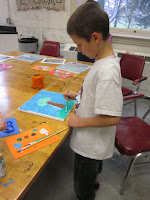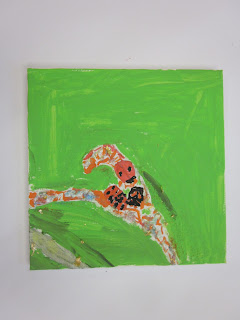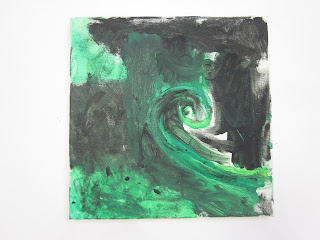Tuesday, March 27, 2012
Week Five: Part 2 Ceramics Shoes
Monday, March 26, 2012
Flying Sculptures
1. Summarizing Before Sending Them Off- Although we spend a good deal of time explaining parts of our lesson and including different activities to get them thinking more about it, we realized this week that it might be a better idea if we summarized more when transitioning between activities and sending them off to work.
2. Stop Saying “Okay?” and “Guys”- We both noticed that after we explain something to the class we say “Okay?” We should not be asking the students if it is okay, what if one day they say “NO!?” We also have both gotten in the habit of addressing our class as “guys.” We need to find another way to address the entire class. (Maybe use the word artists?)
3. Snack Time- Usually we set aside a designated time for the students to eat snack together as a group. This week we planned on having the students decide on their own when they wanted snack so they could have more time to work on the activity, however, we noticed even before we could start our activity, students were already telling us they were hungry. We decided to give them snack during our second book. However, because some of the students have trouble putting their straws in their juice boxes, had to get up to throw away their garbage, and were constantly saying they were “still thirsty” or “still hungry,” it caused more disruption during the story until they were finished eating and could focus on the book more. Also, the fact that we had prepared the snack and placed it right next to our “Story Center,” we think the students were even more distracted and hungry just by seeing it sit there.
What Worked:
1. Lights Off!- Normally when we would like our students to stop their activity and look up at us and listen to the next directions, we say “freeze!” and everyone stops to listen to us. This week we turned the lights off even before saying “freeze” and the students stopped even more quickly than usual.
2. Note Taking- This week, we decided to take more notes on what we noticed the students saying and doing as they were working. We found this to be extremely beneficial to our own learning and teaching experience.
- Emerson has shown us how much thought goes into our students’ creation process She told Katie “this is my house floating under a harbor and the docks.”
- Gabe showed us the importance of experimentation. He drew numerous helicopters as he experimented with how to represent a helicopter. His drawings transformed from small circle with lines extending out to a huge aircraft with windows and stairs for the people on the helicopter.
 | ||
| This is his first interpretation of a helicopter. |
 |
| Notice the last version of a helicopter drawn in green. |
- When Ella was asked what she learned today, she pointed to her drawing and said “This!” She then went on to explain how her drawing was a caterpillar turning into a butterfly.
Lesson 5!
I am really proud of how Katie lead the lesson this week! In general, the whole class went smoothly and the students were engaged for the entirety of it. Great job Katie H!
Successes:
Katie was personable with the students- the kids approached Katie with questions and exciting discoveries
Katie was well prepared-her powerpoint provided impactful images as inspiration. Her demo seem pre-planned because her instructions were fluid
Students were excited to add colored sand and gold-leaf into their works as an added bonus element
Students engaged in the painting process for the entire allotted time
Because Katie did a great job keeping the students engaged, the students took it upon themselves to maintain the materials and not abuse them.
Suggestions for improvement:
It was interesting being the documentor this week because I got the chance to sit back and observe aspects of the class that are sometimes easy to miss while in the moment of teaching. There was one situation that I noticed that I feel could be improved the next time Katie facilitates a lesson:
I noticed that having a powerpoint presentation/discussion during snack time created some distracting factors. It was not a complete disaster by any means, however, I could see some children loosing focus and walk around the room to throw out trash. Having a discussion/powerpoint presentation may work out during snack time if a couple changes were made. Maybe having the students sit together in a semi-circle on the floor facing the screen could allow Katie to keep a close eye on all the students at once. Also, instructing students to keep all trash by their side until after to discussion/presentation would prevent them from walking around the room causing distractions.
Also, in the future, if there is more time than just 2 hours and if the weather outside was better, the students could look at nature with a magnify glass or take their own macro pictures with a zoomed in lens to paint from. The students were very engaged in the images that Katie provided, but allowing them to create their own compositions may be a nice touch to add to the lesson :)
___________________________ Class Works ______________________________________
The students created beautiful work and had many stories to share that related to the image they were painting!!
Noella: Noella painted a frog because she said that she wanted to paint an animal. She offered prior knowledge that she had about canie toads in a side discussion with some classmates. She noted that if someone or another animal ate or squeezed a canie toad, they would die because the toad has poison!
Marisa: Marisa decided to create a cat with a spiral body because she wanted to create something unique and imaginative. She said that she "didn't want to do anything regular".
 (side view of image: bottom is on the left side)
(side view of image: bottom is on the left side) (side view of image: bottom is on the left side)
(side view of image: bottom is on the left side) (side view of image: bottom is on the left side)
(side view of image: bottom is on the left side) (side view of image: bottom is on the left side)
(side view of image: bottom is on the left side)Recycle
The introduction was watching two videos first a water bottle recycle organization that creates sculptures with just water bottles and the second was a Dale Chihuly video. The students were extremely into both videos even though we had doubts if they would stay interested in both. Some students liked the water bottle video more then the Dale and vise versa. This led to a really great discussion about both topics because students were interested in both. Also, one of the students Rachel talked about how she is actually making blown glass bowls for arts fest with her mom and sister. Rachel doesn't usually talk so we were very excited to here from her.
The demo Larissa and I decided went a little long. We noticed that the kids lost interest after the first few minutes or didn't really pay attention at all. This could be because we had a long introduction or because many of them couldn't see the demo. We decided that we will not do as long of a demo in the next weeks again and/or do a long introduction.
The students really enjoyed working on the manipulation of the water bottles. They always surprise us with their artistic talents. Many of them came up with new ways that we did not have examples of to manipulate their bottles. For instance, Bram started poring the neon paint into the water bottles and shook up different colors to get almost a tie die effect. This was not an example but a very interesting way to use the paint that he came up with all on his own.
One of the main issues we had during class was that one of the kids David gets really worked up over using hazardous materials, such as hot glue guns and today he had a huge problem with the melting of the water bottles. He first refused to melt his bottles, which was fine and we told him he could manipulate them in other ways and then he decided that he would not participate in the project all together because it could be possibly toxic. I gave him a face mask to where inside the class room no where near the melting area outside and he finished two bottles and said he would not do anymore. I told him that if he didn't want to do anymore bottles then that was fine but I showed him the images we had of the final products on the wall and said I want you to know that when we piece them all together that you will only have two bottles to contribute and I don't want to see you upset when everyone else has many more in the sculptures. He said that he wouldn't be upset so we let him sketch for the remainder of the time.
Other then Davids little meltdown "literally" the class went smoothly. Except for we decided that we needed to limit the painting center for next week to only puff paint, which was their favorite to use, because it was extremely messy and created a lot of chaos and was a lot to clean up.
lesson 5

| Unit Title: Exploring Nature's Elements Through Art | ||
| Lesson Title: up close and earthy | ||
| Grade Level/Ages: Late Elementary/Ages 8-9 | Instructors: Katie Hopkins & Maddie Tyska | |
| Day /Date of lesson: March 23, 2012 | Room No: 204 | No of Students: 22 |
REFLECTION BEOFRE LESSON:
I got to bed early and I feel awake and ready to teach this lesson. I am wearing a silk Indian style shirt that is loose and comfortable and blue slacks. I am at Saints café with jeff and I like having this extra time in the morning.
Today I want to show my personality in today’s lesson and have a sense of humor during my discussion. This class should be fun for the kids. I feel comfortable with teaching painting and macro photography because I know a lot about it.
REFLECTION AFTER LESSON:
I felt good during the lesson and the kids were very excited when they saw the macro images in the presentation. I am glad I used the projector because the students were really engaged by the clear images. It was a little distracting that they were eating their snack at this time because they kept getting up to throw away their trash. They really grasped the definition of macro photography with the foreground having more detail and the background having less detail. They were a little more confused about the definition of composition, but they were trying to understand. I should have drawn a grid on the board to show them how good compositions fit with in the intersecting points on a grid. I was glad Ez didn’t let me move on until he could comprehend the definitions.
I am glad I had the sand and gold leaf for them to add to their paintings because it added another step incase the painting was not enough for them. They also had the option of not using the sand and gold. I really tried to encourage the students to cover their whole canvas with paint and not leave the white gesso showing. I could have gone into more detail about how the canvas is made but that would have taken up more time away from painting. I talked to a couple students about how a canvas is made and they explained to me the canvas is pulled tight with staples.
I am glad I had the students think about the edges of their canvas because that is something the viewer will see and should be thought about. The students really caught on to why we did pencil sketches from the images because they saw that they were transforming it into their own style. At the end of the lesson the students kept saying how much fun they had because they got to draw and paint. The macro photography concepts really made sense to them because it was not overwhelming to focus on the subject and to blur the background. The students were really engaged with the demo and followed me around the room, and Myoungsun said that meant the kids were really interested.
This is a lesson I can see myself teaching again, but next time I would plan on talking about composition and would have a clearer definition.





Sunday, March 25, 2012
Mallory & Jen Week 5: House Junk
 |
| This photo shows Kate sorting her junk in some of the bins. |
Our class straw light is always a nice activity that students can collect themselves at if needed, or be a part of a more quiet and relaxed activity, because only two friends can work on the light at one time. Below are two students working on the light!
We added a mobile center after their class made their individual mobiles a few weeks ago, so we decided to hang a large one at a center so students can come and go to the mobile, adding objects as they wish. Some students make little sculptures with the junk and hang those from the mobile! Here a student attaches an object to keep the mobile balanced!






































